

To send a message to an author, click on the author's name at the end of the article.
This Month in Ag Connection | Ag Connection - Other Issues Online

Agriculture workers spend many hours working in the sun. The best way to reduce your exposure to sun and heat hazards is to be proactive in preparing for working in the heat.
Heat Exposure: The combination of heat and humidity can pose health problems during prolonged exposure to the elements. Some things that you can do to be proactive in reducing your heat stress are:
Sun Exposure: The ultraviolet (UV) radiation in sunlight causes premature aging of the skin, wrinkles, cataracts, and skin cancer. Many people think that after an initial suntan they are safe from the ill effects of sun for the rest of the season. This is just not true. Suggested practices to reduce damage from sun exposure include:
Don't forget to think of your teenagers who believe they are "bullet proof". If they are working at summer jobs this year, you may want to check out these websites related to safety and youth:
Reference: OSHA Fact Sheet
(Author: Todd Lorenz, Horticulture/Agronomy Specialist)
This Month in Ag Connection | Ag Connection - Other Issues Online

Terry Gompert, a Nebraska extension specialist and farmer, shared his experiences on grazing corn at the Summer Grazing Workshop at the MU Forage Systems Research Center (FSRC). He noted that at first helpful neighbors would stop to tell him that his cows were in the corn. Now people around Center, Nebraska are accustomed to seeing cows - and yearling steers - grazing cornfields on the Gompert's farm and the farms of his neighbors.
Gompert started by feeding 100 steers on standing corn, letting the cattle harvest the crop. He used an electric poly-tape, moved daily, to control the amount of feed available to the cattle. People already using Management-intensive Grazing (MiG) are already accustomed to this practice. Instead of selling calves at 600 pounds, they were grazed to 1,000 pounds, taking them nearer to a finished weight.

The steers must be managed much as if they were in a feedlot, working them up to a full ration of corn. Allowing access to too much corn at one time can lead to acidosis, founder and in extreme cases death. Farmers must "read the feed bunk" and "read the cattle every day". If the steers come running when called, that means they were not given enough feed the day before. If they ignore the call, then they were fed too much.
Cattle on feed require close management. The "feed bunk" for Mr. Gompert's 100 steers was a 100-foot by 100-foot patch of corn. The number of rows set off for grazing can be adjusted daily to meet the feed needs. When the grazing allotment was sized correctly, few cornstalks were left after a day of grazing, especially on green corn. His records indicated about a $100-an-acre savings from cattle grazing corn instead of harvesting, storing and feeding it.
Gompert recommends a regular-season, high-yield corn variety, instead of a silage variety. He suggests corn be managed for a high grain yield. (Note: In Missouri during dry years, nitrates could be a problem.) With corn selling for less than $2 per bushel in Nebraska, he figures the crop is worth more for grazing. Gompert urged restraint when grazing cows. Cut back on how much is fed to keep cows from getting too fat.
An easy way to start the cattle grazing corn is to turn them in after the corn has tasseled. As the ears of corn begin to develop, the cattle begin to get more grain. In the beginning, estimate the amount of dry matter available. Then fence off enough for the steers to eat about 3 percent of their body weight. From the first day, you start adjusting the amount of feed offered. To stimulate the appetite when corn leaves turn brown, feed about a pound of soybean meal per head every day.
Colored poly tape makes a good portable fence. It flutters in the wind and is more visible than electric wire. Knock down a row of corn for the electric fence -- cattle must see the fence. Gompert also recommends setting a second fence that can be used for the grazing plot the next day. If the cattle get out of the first fence, it is easier to get them out of 100 feet of corn than out of a 100-acre field. It is suggested that cattle should be trained to an electric fence before starting this practice.
Gompert suggested that cattle gaining less than a half-pound per day on fescue in summer could gain more than two pounds per day on corn. And, he noted, it will get the attention of your neighbors. "They'll talk about you."
Additional web resources on grazing corn are:
The sources for this article are Jim Gerrish, Research Assistant Professor of Agronomy (660) 895-5121, Terry Gompert, Nebraska Livestock Specialist and farmer (402) 288-4224, and Jim Jarman, Agronomy Specialist, (573)642-0755. University of Missouri of Missouri Extension programs are open to all.
This Month in Ag Connection | Ag Connection - Other Issues Online

Most producers would like to extend their grazing season as much as possible. According to Robert Kallenbach, University of Missouri State Forage Specialist, "the expense of producing, making and feeding hay accounts for approximately 50% of the cost to produce beef and 30% of the cost to produce milk in Missouri". Feeding hay "eats up" a lot of potential profit that could ultimately go into a producer's pocket. Stockpiling fescue may be the most popular way of cutting the expense of feeding hay, but it has some problems. Click here to view article on stockpiling fescue in the August 2002 issue of Ag Connection.
Utilizing brassicas is an alternative to stockpiling fescue in Missouri. Brassicas include: turnips, kale, swede, and forage rape. Brassicas can be no-tilled into small-grain stubble, killed sod, permanent pasture which has been grazed short, or following the plow down of legume as the brassicas can use the residual nitrogen. It is recommended brassicas be planted in late August or early September. Plant at a depth of one-fourth to one-half inch with a seeding rate of 1.5 to 2 pounds per acre for turnips and swedes and 3.5 to 4 pounds per acre for rape and kale. Good soil drainage is beneficial as the brassicas will experience crown and root rot if planted in poorly drained areas. It is best to grow them on soils with a pH between 5.3 and 6.8 with medium levels of phosphorus and potassium while applying 50 to 75 pounds of nitrogen at planting. One could also broadcast the seed with the fertilizer. Don't plant brassicas in the same area more than two consecutive years due to disease buildup.
Strip grazing is the best way to utilize these forages (rotating every one or two days). Most of the brassicas will regrow if not grazed below 6 inches. When grazing brassicas precautions should be taken because they are very high quality and are considered similar to concentrate feeds. It is important not to turn hungry animals into the brassica pasture. Livestock need to be slowly introduced to the brassica pasture over a 3 to 4 day period. Brassica crops should not constitute more than 65-70% of their diet. Grazing brassicas along with stockpiled hay or no-tilling into grass sod would be a great management scheme. Most of the health problems that are seen with grazing brassicas occur because the livestock aren't properly managed and they over-consume the brassicas. Some of the problems seen include: bloat, atypical pneumonia, nitrate poisoning, hemolytic anemia (mainly kale), hypothyroidism and polioencephalomalacia. They can all be avoided with good management and a high-quality mineral supplement. With good management and timely rains, brassicas can postpone the need to feed more expensive hay and other supplements.
For more information check out these websites on grazing brassicas.
(Author: Wendy R. Flatt, Livestock Specialist)
This Month in Ag Connection | Ag Connection - Other Issues Online

Johann Bruhn and Jeanne Mihail have studied how shiitake mushrooms could be produced as an agricultural commodity under the Missouri forest canopy. The research is one of several ongoing projects at the MU Center for Agroforestry that examine how forest farming can provide additional income for landowners growing high-quality trees for wood products.
Bruhn and Mihail said shiitake mushrooms are an excellent choice for Missouri forest farming. A high-value product that requires few inputs, the mushrooms can be grown outdoors using wood that has little commercial value.
There are many variables to consider when growing mushrooms outdoors. The research is focused on studying the variables most critical to outdoor shiitake production in Missouri.
Click here for more information on the research.
This Month in Ag Connection | Ag Connection - Other Issues Online

The IRS's position on how CRP and similar land idling program payments should be reported was made clearer with a recent Chief Counsel's ruling (CCA Ltr. Rul. 200325002). This ruling addressed two fact situations involving CRP payments. In the first situation, the taxpayer was engaged in the trade or business of farming and bid land into the CRP. The second dealt with a taxpayer, not involved in the trade or business of farming, who acquired land that had already been bid into CRP. This ruling stated that CRP payments in both situations should have been reported on Schedule F and were liable for self-employment tax.
This latest CCA ruling on the second fact situation is at variance with prior Private Letter Rulings and commentary issued with Tax Court decisions.
Legislation to exempt all CRP payments from self-employment tax was introduced for consideration in legislative bills of 2000, 2001, and 2003. The 2003 letter ruling appears to be solidifying efforts to get legislative action to clearly define Congress's intent relative to the circumstances when, if ever, CRP and other similar land idling program payments will be subject to self-employment tax.
It is important you make your position regarding this issue known to your U.S. senator and representative. Taxpayers and tax professionals deserve certainty and closure on this issue that has been bouncing from one position to the other since 1988.
(Author: Parman R. Green, Ag Business Specialist)
This Month in Ag Connection | Ag Connection - Other Issues Online
Publishing Information
Ag Connection is published monthly for Northeast and Central areas of Missouri producers and is supported by the University of Missouri Extension, the Missouri Agricultural Experiment Station, and the MU College of Agriculture, Food and Natural Resources. Managing Editor: Mary Sobba.